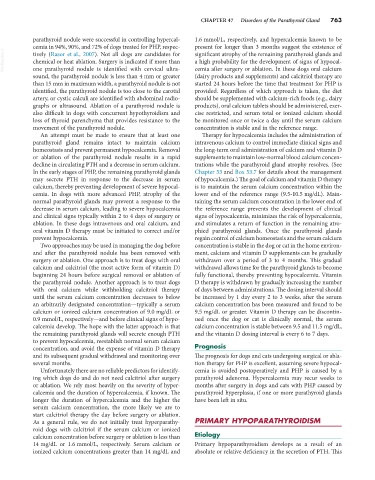Page 791 - Small Animal Internal Medicine, 6th Edition
P. 791
CHAPTER 47 Disorders of the Parathyroid Gland 763
parathyroid nodule were successful in controlling hypercal- 1.6 mmol/L, respectively, and hypercalcemia known to be
cemia in 94%, 90%, and 72% of dogs treated for PHP, respec- present for longer than 3 months suggest the existence of
VetBooks.ir tively (Rasor et al., 2007). Not all dogs are candidates for significant atrophy of the remaining parathyroid glands and
a high probability for the development of signs of hypocal-
chemical or heat ablation. Surgery is indicated if more than
one parathyroid nodule is identified with cervical ultra-
(dairy products and supplements) and calcitriol therapy are
sound, the parathyroid nodule is less than 4 mm or greater cemia after surgery or ablation. In these dogs oral calcium
than 15 mm in maximum width, a parathyroid nodule is not started 24 hours before the time that treatment for PHP is
identified, the parathyroid nodule is too close to the carotid provided. Regardless of which approach is taken, the diet
artery, or cystic calculi are identified with abdominal radio- should be supplemented with calcium-rich foods (e.g., dairy
graphs or ultrasound. Ablation of a parathyroid nodule is products), oral calcium tablets should be administered, exer-
also difficult in dogs with concurrent hypothyroidism and cise restricted, and serum total or ionized calcium should
loss of thyroid parenchyma that provides resistance to the be monitored once or twice a day until the serum calcium
movement of the parathyroid nodule. concentration is stable and in the reference range.
An attempt must be made to ensure that at least one Therapy for hypocalcemia includes the administration of
parathyroid gland remains intact to maintain calcium intravenous calcium to control immediate clinical signs and
homeostasis and prevent permanent hypocalcemia. Removal the long-term oral administration of calcium and vitamin D
or ablation of the parathyroid nodule results in a rapid supplements to maintain low-normal blood calcium concen-
decline in circulating PTH and a decrease in serum calcium. trations while the parathyroid gland atrophy resolves. (See
In the early stages of PHP, the remaining parathyroid glands Chapter 53 and Box 53.7 for details about the management
may secrete PTH in response to the decrease in serum of hypocalcemia.) The goal of calcium and vitamin D therapy
calcium, thereby preventing development of severe hypocal- is to maintain the serum calcium concentration within the
cemia. In dogs with more advanced PHP, atrophy of the lower end of the reference range (9.5-10.5 mg/dL). Main-
normal parathyroid glands may prevent a response to the taining the serum calcium concentration in the lower end of
decrease in serum calcium, leading to severe hypocalcemia the reference range prevents the development of clinical
and clinical signs typically within 2 to 4 days of surgery or signs of hypocalcemia, minimizes the risk of hypercalcemia,
ablation. In these dogs intravenous and oral calcium, and and stimulates a return of function in the remaining atro-
oral vitamin D therapy must be initiated to correct and/or phied parathyroid glands. Once the parathyroid glands
prevent hypocalcemia. regain control of calcium homeostasis and the serum calcium
Two approaches may be used in managing the dog before concentration is stable in the dog or cat in the home environ-
and after the parathyroid nodule has been removed with ment, calcium and vitamin D supplements can be gradually
surgery or ablation. One approach is to treat dogs with oral withdrawn over a period of 3 to 4 months. This gradual
calcium and calcitriol (the most active form of vitamin D) withdrawal allows time for the parathyroid glands to become
beginning 24 hours before surgical removal or ablation of fully functional, thereby preventing hypocalcemia. Vitamin
the parathyroid nodule. Another approach is to treat dogs D therapy is withdrawn by gradually increasing the number
with oral calcium while withholding calcitriol therapy of days between administrations. The dosing interval should
until the serum calcium concentration decreases to below be increased by 1 day every 2 to 3 weeks, after the serum
an arbitrarily designated concentration—typically a serum calcium concentration has been measured and found to be
calcium or ionized calcium concentration of 9.0 mg/dL or 9.5 mg/dL or greater. Vitamin D therapy can be discontin-
0.9 mmol/L, respectively—and before clinical signs of hypo- ued once the dog or cat is clinically normal, the serum
calcemia develop. The hope with the latter approach is that calcium concentration is stable between 9.5 and 11.5 mg/dL,
the remaining parathyroid glands will secrete enough PTH and the vitamin D dosing interval is every 6 to 7 days.
to prevent hypocalcemia, reestablish normal serum calcium
concentration, and avoid the expense of vitamin D therapy Prognosis
and its subsequent gradual withdrawal and monitoring over The prognosis for dogs and cats undergoing surgical or abla-
several months. tion therapy for PHP is excellent, assuming severe hypocal-
Unfortunately there are no reliable predictors for identify- cemia is avoided postoperatively and PHP is caused by a
ing which dogs do and do not need calcitriol after surgery parathyroid adenoma. Hypercalcemia may recur weeks to
or ablation. We rely most heavily on the severity of hyper- months after surgery in dogs and cats with PHP caused by
calcemia and the duration of hypercalcemia, if known. The parathyroid hyperplasia, if one or more parathyroid glands
longer the duration of hypercalcemia and the higher the have been left in situ.
serum calcium concentration, the more likely we are to
start calcitriol therapy the day before surgery or ablation.
As a general rule, we do not initially treat hyperparathy- PRIMARY HYPOPARATHYROIDISM
roid dogs with calcitriol if the serum calcium or ionized
calcium concentration before surgery or ablation is less than Etiology
14 mg/dL or 1.6 mmol/L, respectively. Serum calcium or Primary hypoparathyroidism develops as a result of an
ionized calcium concentrations greater than 14 mg/dL and absolute or relative deficiency in the secretion of PTH. This

